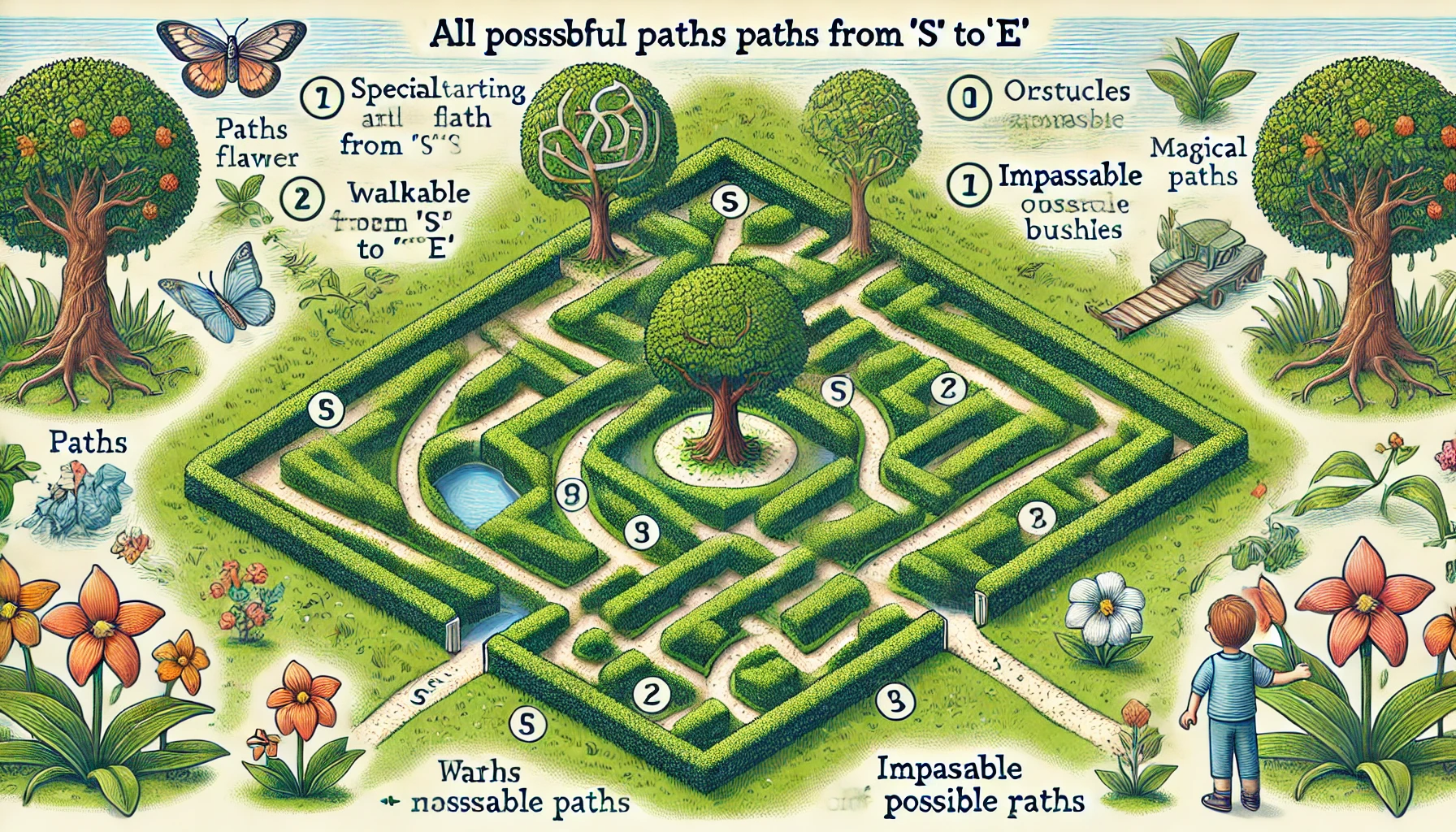Find All Paths in a Maze
 Abhi
Abhi
You are given a 2D grid representing a maze where:
'S' represents the starting point,
'E' represents the ending point,
'0' represents open paths, and
'1' represents walls.
You need to find all possible paths from 'S' to 'E' using backtracking. You can move up, down, left, or right, but you cannot move through walls.
Example
Input:
const maze = [
['S', '0', '1', '0'],
['0', '1', '0', '0'],
['0', '0', '0', '1'],
['0', '1', 'E', '0']
];
Output:
[
[[0, 0], [1, 0], [2, 0], [2, 1], [2, 2], [3, 2]]
]
This output represents the path from 'S' to 'E' as a list of coordinates.
Function Declaration:
function findPathsInMaze(maze) {
// Your implementation goes here
}
Great! Let's break down the approach to solve this problem using backtracking.
Step 2: Short, Easy-to-Remember Solution/Approach
Identify the starting point ('S') in the maze.
Use a backtracking function to explore all possible paths:
Move in all four possible directions (up, down, left, right).
Keep track of the current path.
If you reach the endpoint ('E'), save the path.
Mark cells as visited to avoid cycles and unmark them when backtracking.
Return all found paths.
Step 3: Solution in JavaScript with Code Commenting
Here's the complete code with comments explaining each step:
function findPathsInMaze(maze) {
const rows = maze.length;
const cols = maze[0].length;
const paths = [];
// Helper function for backtracking
function backtrack(row, col, path) {
// Base case: if out of bounds or hits a wall
if (row < 0 || col < 0 || row >= rows || col >= cols || maze[row][col] === '1') {
return;
}
// Base case: if the endpoint is reached
if (maze[row][col] === 'E') {
path.push([row, col]);
paths.push([...path]);
path.pop();
return;
}
// Mark the cell as part of the path
const temp = maze[row][col];
maze[row][col] = '1'; // Mark as visited
path.push([row, col]);
// Explore the four possible directions
backtrack(row + 1, col, path); // Move down
backtrack(row - 1, col, path); // Move up
backtrack(row, col + 1, path); // Move right
backtrack(row, col - 1, path); // Move left
// Unmark the cell (backtrack step)
maze[row][col] = temp;
path.pop();
}
// Start backtracking from the starting point
for (let i = 0; i < rows; i++) {
for (let j = 0; j < cols; j++) {
if (maze[i][j] === 'S') {
backtrack(i, j, []);
break;
}
}
}
return paths;
}
// Example usage:
const maze = [
['S', '0', '1', '0'],
['0', '1', '0', '0'],
['0', '0', '0', '1'],
['0', '1', 'E', '0']
];
console.log(findPathsInMaze(maze));
Step 4: Explanation of the Solution in Simple Terms
Explanation for a 10-year-old: Imagine you are in a garden maze. You start at a special flower (S) and want to find all possible ways to reach the magical tree (E). You can only walk on grass (0) and cannot go through bushes (1). You decide to try every possible path, marking where you have walked so you don't go in circles, and once you find the magical tree, you remember that path. After trying every way, you tell all the paths you found.
Step 5: Code Explanation in Pointers
Identify the starting point: Loop through the maze to find 'S'.
Backtrack function: Define a helper function to explore paths.
Base cases: Return if out of bounds, hit a wall, or reach 'E'.
Mark cell as visited: Temporarily mark the cell to avoid revisiting.
Explore directions: Recursively explore up, down, left, and right.
Unmark cell: Backtrack by unmarking the cell.
Start backtracking: Call the backtracking function from the starting point.
Return paths: Collect and return all valid paths.
Step 6: Complexity Analysis
Time Complexity: O(4^(n*m)), where
nis the number of rows andmis the number of columns. This is because, in the worst case, every cell could lead to four recursive calls.Space Complexity: O(n*m), due to the recursion stack and path storage.
Subscribe to my newsletter
Read articles from Abhi directly inside your inbox. Subscribe to the newsletter, and don't miss out.
Written by
